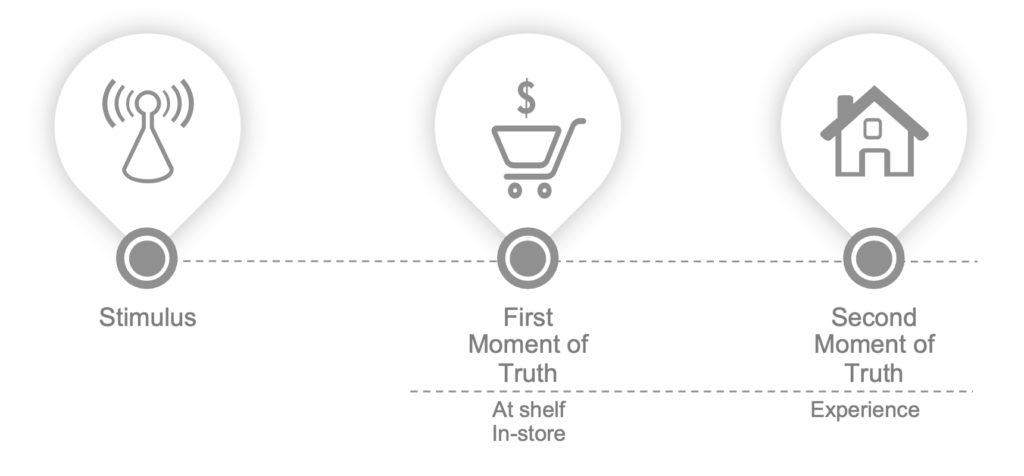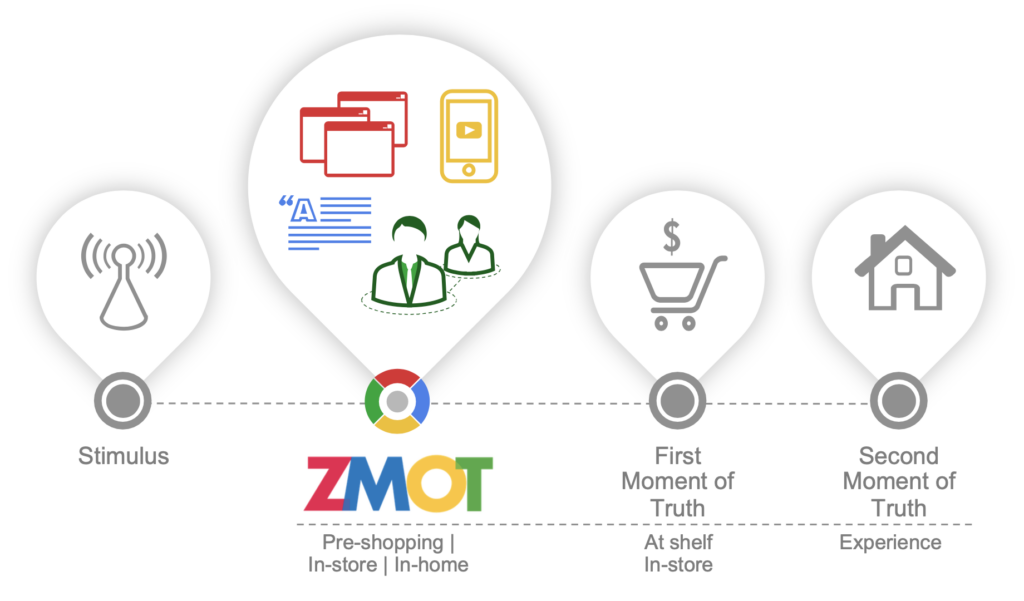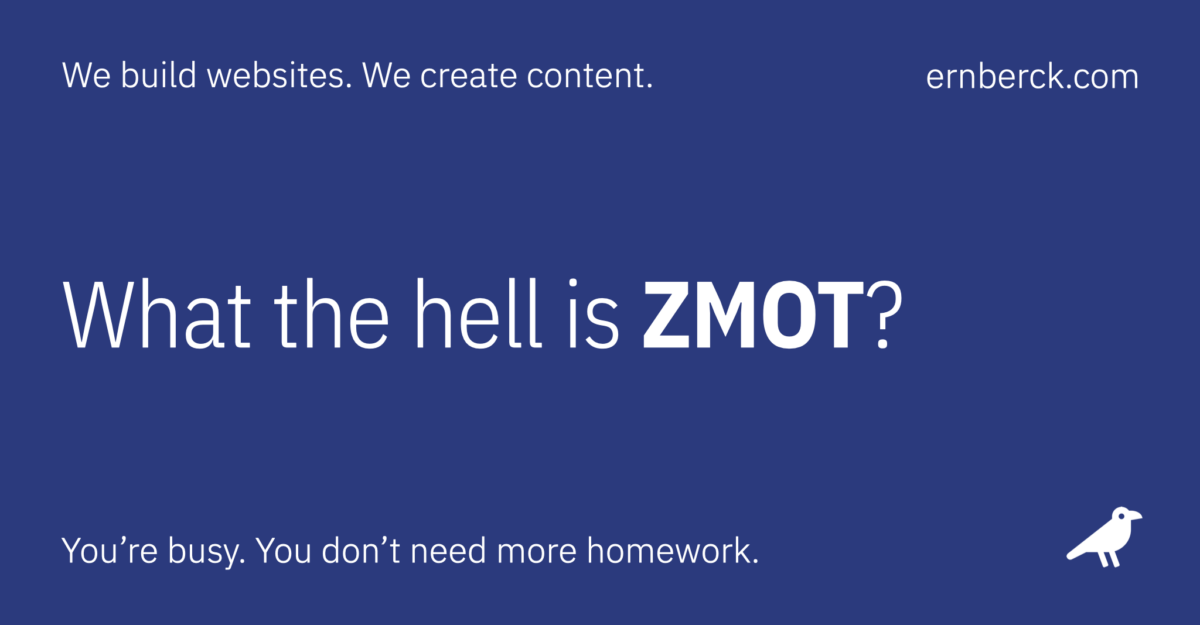The internet has forever changed how we decide what to buy. Google calls this online decision-making moment the zero moment of truth – or simply ZMOT.
What is a moment of truth?
In marketing, a “moment of truth” refers to a critical point in a customer’s journey when they make a decision that significantly impacts their perception of a brand, product, or service. The concept that was popularized in 2005 by A.G. Lafley, the CEO and chairman of Procter & Gamble, to emphasize the importance of customer interactions and experiences.
Traditionally, there are three moments of truth:
01. First moment of truth (FMOT)
The first moment of truth occurs when a customer encounters a product or service for the first time in a physical store, online marketplace, or through advertising.
The customer forms an initial impression based on packaging, product presentation, or website design. The goal of the marketer is to capture the customer’s attention and entice them to make a purchase.
02. Second moment of truth (SMOT)
The second moment of truth happens after the customer has bought the product or used the service. It involves the customer’s actual experience with the product, which shapes their perception and influences future purchasing decisions.
There can be multiple second moments of truth for every time a product or service is consumed or used. This often provides the customer with information for future purchases and for sharing their experience with others.
03. Third moment of truth (TMOT)
The third moment of truth refers to the customer’s feedback, opinions, and reviews that are shared with others about their experience.
With the rise of social media, ecommerce, and other online platforms, consumers now have a powerful voice to express their thoughts and influence new potential customers.
At this point in the purchase journey, companies need to actively monitor and respond to customer feedback to maintain their reputation and address any complaints or concerns.

What is the zero moment of truth?
The concept of the “zero moment of truth” (ZMOT) was introduced by Google in 2011 to capture and explain evolving consumer behavior in the digital age. ZMOT refers to the moment when a consumer actively researches a product, service, or brand online before making a purchase decision.
Historically, the first moment of truth (FMOT) occurred when a customer encountered a product for the first time when in a physical store. Today, with the advent of the internet and the widespread use of smartphones and other digital devices, consumers now have direct access to vast amounts of product information delivered by hundreds of online channels, including:
- Search engines
- Social media platforms
- Review websites
- Review videos
- Product comparison sites
- Ecommerce sites
During the zero moment of truth — before committing to a purchase — most consumers actively engage these channels to educate themselves, compare pricing, and seek recommendations from trusted friends and influencers.

ZMOT in daily life
The zero moment of truth is that moment when you grab your laptop, mobile phone, tablet, or some other connected device, and start learning about a product or service that you’re thinking about buying.
A zero moment of truth is:
What is user-generated content?
User-generated content (UGC) refers to any form of content, such as text, images, videos, reviews, or other media, that is created and shared by individual users rather than by professional content creators or organizations. UGC is typically produced and published by the users of a particular platform, website, forum, or online community.
There’s a lot of hype around UGC, but it’s got some downsides:
User-generated content can be a marvelous tool, but use caution if you rely upon it heavily in your marketing strategy. Remember: Once something gets published, it can exist forever.
Making ZMOT work for your business
The zero moment of truth is crucial for marketers because it represents a key opportunity to influence a customer’s perceptions and decisions before the purchase. By providing timely, relevant, and valuable information, brands can establish trust, showcase product features and benefits, and differentiate themselves from competitors.
But although the “moments of truth” concept is still valid and powerful, keep in mind that the internet has changed forever the way consumers are interacting with brands, products, and services.
Ten years ago, if you were looking to purchase a product or service — or just do some preliminary research — you probably started by using a search engine, such as Google or Bing. But that was before social media took over.
Today, millions of potential customers use social media feeds for browsing and information gathering — and they only click through to websites when they find something useful or interesting. This is a massive shift in how people find, evaluate, and use product information.
Leveraging ZMOT
To leverage ZMOT effectively, today’s marketers need to:
- Build a fast, well-designed, accessible, responsive, and engaging website.
- Publish relevant website articles on a regular basis (once per month is fine).
- Optimize your article content for visitors, not search engines.
- Be aware that artificial intelligence (AI) will drastically change the rules of search engine optimization (SEO).
- Maximize the value of your content by repurposing it to share on social media.
- Create content once, and share it everywhere. Then share it again.
- Amplify your reach by using multiple social media channels, not just one or two.
- Don’t be afraid to repeat yourself on social media. You need both reach and frequency to impact potential customers.
- Make sure that your brand has a strong online presence.
- Actively manage your online reputation across all social media channels.
- Encourage positive reviews and user-generated content (see box above).
- Provide a seamless experience across all of your digital touchpoints.
Focus on the needs and preferences of customers during the zero moment of truth.This will help position your business favorably and increase the likelihood of customers choosing your brand when they reach the first moment of truth and make a purchase.
90% of life is showing up
It’s easy to get overwhelmed by all of the social media choices and “expert” advice. Don’t let it get to you — Most of what you read is nonsense. Social media marketing is just the game you have to play because potential customers will look around and wonder why you didn’t show up.
They’ll notice your absence more than your presence.
Summary
Understanding and optimizing “moments of truth” can help marketers create effective strategies to attract, engage, and retain customers.
But reaching people at the zero moment of truth has changed since the concept was introduced in 2011. Today, millions of potential of customers start their purchase journey on social media instead of a traditional search engine.
To adjust to this change in the customer journey, you’ll need a system to publish regular content (text, images, video, etc), not only to your website, but to as many social media platforms as possible. This can be accomplished by publishing quality content to your website on a regular basis, then re-posting this content to your social media channels.
By delivering useful content consistently throughout the customer journey, brands can build trust, loyalty, and long-term customer relationships.
Related
- Content marketing still works
- How to promote your website
- Social proof explained
- The truth about social media engagement
